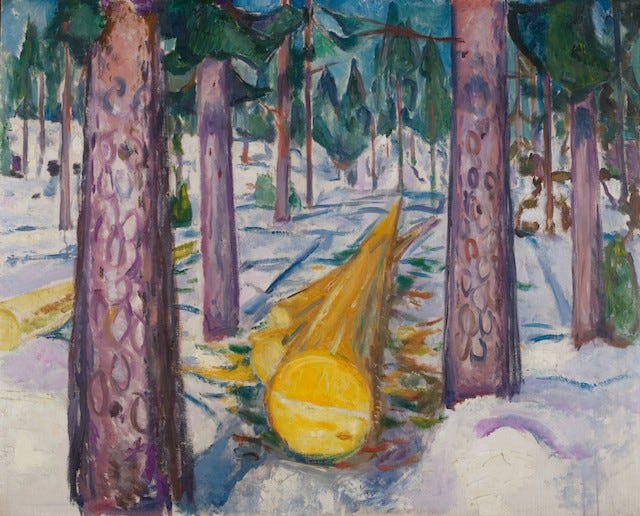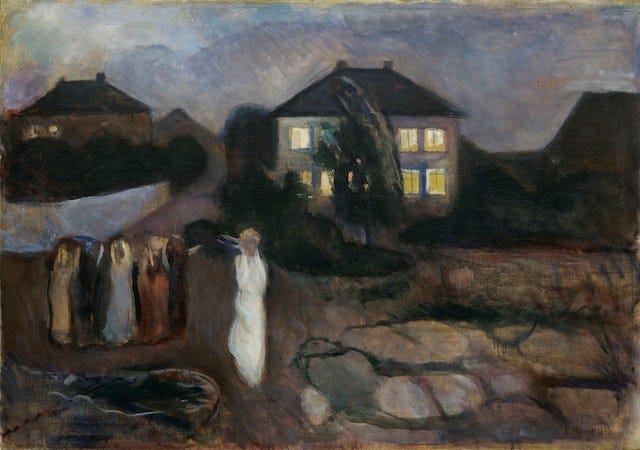My Summer of Munch
The powerful emotions rendered in and extending outward from Munch’s work have given me a mystical experience, an inner glimpse, a close encounter with one of the great prophets of the 20th century

(HUDSON, N.Y., October 6, 2023) - In no small way, this turned out to be the summer of Edvard Munch for me. This was not surprising, as Munch has long been my favorite artist, the one who speaks to me most directly both intellectually and emotionally. If I have a radio tuner inside my brain and my heart, its default station is tuned to all-Munch, all the time.
I can’t pinpoint when Munch really got a hold on me, but it may have been when the Met Breuer in New York City featured a huge retrospective of his work—Edvard Munch: Between the Clock and the Bed--in late 2017/early 2018, although I must already have had some notion that Munch was my touchstone, else I would not have made the pilgrimage to see the exhibition not once but twice. Like everyone else, I knew Munch’s iconic image, The Scream, and maybe that is all it took to get me in the door. Once inside, I was bruised, devastated, battered, and intoxicated by Munch’s vast oeuvre and the way he kept coming back to a few of the same themes and ideas running through almost all of his work. For Munch, he was not portraying people or scenes – even though the vast majority of his work contained people and scenes – but rather “the memory of emotion.” Even the various iterations of The Scream that were included in the exhibition belied the notion that the image was some sort of cliché (it may be one now, but not due to any fault of Munch’s) as opposed to the artist channeling the angst of isolation—indeed, the angst of the human condition—as the calendar page turned from the nineteenth to the twentieth century.
Munch saw the future, and it was frightening. As such, his work was a kind of prophecy, not in the sense of future-telling, but more in the Biblical sense, wherein a prophet—someone gifted with the highest degree of cultural sensitivity—warns an assembled group (in Munch’s case, his viewers) of dark days ahead, not merely as a harbinger of gloom and doom but rather to shake them into action, to mend their ways and resist the powerful forces of history that threaten to obliterate their humanity. In this way, Munch was (and remains) nothing less than a prophet.
Over the past few years, my obsession with Munch has only grown, and I knew that in order to appreciate fully his life and work I had to make the pilgrimage to Norway to see his work in its original context, to walk the very same streets portrayed in his crowd scenes, to dine at the very same café where he hung out with fellow artists, thinkers, and authors, and to soak in the surroundings that both fueled and permeated his imagery.
I have already written about my trip to Norway elsewhere, but to reiterate, I saw his work at the Munch Museum in Oslo, but also in various other locations in Oslo and elsewhere in Norway, especially in Bergen. Munch painted monumental murals in a lecture hall at the university in Oslo; the National Gallery holds a good selection of some of his greatest hits (including my all-time favorite, Ashes); and the museum in Bergen also possesses several of his best-known works.
Before I even left for Norway, I learned that Munch was coming to the Berkshires, in the form of Edvard Munch: Trembling Earth, an exhibition curated by and presented at the Clark Art Institute in Williamstown, Mass., through Sunday, October 15, 2023. The exhibition catalog describes the show as “the first major attempt to explore the importance of Munch’s depictions of nature in depth and the challenge common conceptions.”

A visit to this wonderful exhibition rounded out my summer of Munch. I am not sure exactly how the show “challenged common conceptions,” but it certainly was successful in demonstrating how Munch found the same ominous themes in landscapes, forest scenes, and in portraits of people in nature that he did in his darker, interior paintings. The exhibition also included a number of Munch’s nightscapes, including The Storm and his series of Starry Night paintings, that may serve as the connective bridge between his interiors and exteriors.
Attempting to separate Munch’s so-called nature paintings from his other work may have been merely an academic exercise or possibly a fool’s errand, but in the end it doesn’t really matter. The Clark’s exhibition made a bunch of Munch’s work accessible to regional audiences (as well as those who came from far and wide, I’m sure), and that in itself is to be lauded. Most of Munch’s work dates back 100 years or longer, but it remains vital, urgent, and immediate. The portrayal of a fallen yellow log in a forest in The Yellow Log packs as much action and anxiety as does The Scream. Ominous tree branches threaten to overwhelm a group of children in the foreground in The Fairytale Forest. Paintings including Girls on the Bridge, Girls on the Pier, and The Women on the Bridge are all variations or emendations of The Scream, which in and of itself can be viewed as a “nature painting” or a landscape: its blood-red sky and heavy swirls of green and blue representing water and land as seen from the bridge are as essential to the iconic painting as the ghostlike, faceless human that has come to represent twentieth-century humanity—or inhumanity, as the case may be.
I may not ever experience another season so full of firsthand encounters with Munch’s work. But Munch’s work will always be with me, will always be inside me. The powerful emotions rendered in and extending outward from Munch’s work have given me a mystical experience, an inner glimpse, a close encounter with one of the great prophets of the twentieth century.
Hey, did you like this edition of Everything Is Broken? If so, please consider clicking on the “LIKE” button at the very end of this message. It matters to the gods of Substack.
Roll Call: Founding Members
Anne Fredericks
Anonymous (5)
Erik Bruun
Benno Friedman
Richard Koplin
Steve and Helice Picheny
Rhonda Rosenheck
Elisa Spungen and Rob Bildner/Berkshires Farm Table Cookbook
Julie Abraham Stone
Mary Herr Tally




Seth: this is so beautifully written! I saw the Munch exhibit early in the summer and was truly amazed that he did landscapes. Thanks for the reminder and now I have another great reason to go to Norway.
I saw the Munch Exhibit at the Clark yesterday. I was moved by the intense emotion turmoil of his work. I was intrigued, also, by his application of paint: sometimes applying it thickly in some sections and barely covering the canvas in other sections. I'd love to know what his thinking/purpose was.